StudyGuider
Study material including course and exam guide for College and University students in the United States.
- 656
- 0
- 75
Community
- Followers
- Following
114 Reviews received
777 items
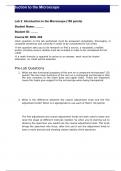
BIOL202 Week 2 Lab 2 Introduction to the Microscope
Lab 2: Introduction to the Microscope (100 points) ▪ Each question on the lab worksheet must be answered completely, thoroughly, in complete sentences and correctly in order to be considered for full credit ▪ If the question asks you to do research or find a source, a reputable, credible and/or scholarly source citation must be included in order to be considered for full credit ▪ If a math formula is required to arrive to an answer, work must be shown otherwise, no credit will be awarde...
- Exam (elaborations)
- • 6 pages •
Lab 2: Introduction to the Microscope (100 points) ▪ Each question on the lab worksheet must be answered completely, thoroughly, in complete sentences and correctly in order to be considered for full credit ▪ If the question asks you to do research or find a source, a reputable, credible and/or scholarly source citation must be included in order to be considered for full credit ▪ If a math formula is required to arrive to an answer, work must be shown otherwise, no credit will be awarde...
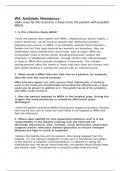
BIOL202 Week 4 Discussion; Antibiotic Resistance
Week 4: Antibiotic Resistance I chose to be the patient with possible MRSA. 1. Is this infection likely MRSA? 2. What would a MRSA infection look like on a patient; for example, describe how the wound presents. 3. Was the patient exposed to MRSA in the hospital prep, during the surgery the week previously or sometime afterwards (post- discharge)? 4. Where does liability for this (potential) infection rest? Is it the responsibility of the patient (making sure she followed her discharge instr...
- Package deal
- Other
- • 2 pages •
Week 4: Antibiotic Resistance I chose to be the patient with possible MRSA. 1. Is this infection likely MRSA? 2. What would a MRSA infection look like on a patient; for example, describe how the wound presents. 3. Was the patient exposed to MRSA in the hospital prep, during the surgery the week previously or sometime afterwards (post- discharge)? 4. Where does liability for this (potential) infection rest? Is it the responsibility of the patient (making sure she followed her discharge instr...
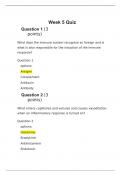
BIOL202 Week 5 Quiz
1. Question: What does the immune system recognize as foreign and is what is also responsible for the induction of the immune response? 2. Question: What enters capillaries and venules and causes vasodilation when an inflammatory response is turned on? 3. Question: What describes how a host defends itself against an invading pathogen? 4. Question: What is excluded in the group of cellular defenses of macrophage? 5. Question: How are antigens described? 6. Question: What cells specialize to ...
- Exam (elaborations)
- • 7 pages •
1. Question: What does the immune system recognize as foreign and is what is also responsible for the induction of the immune response? 2. Question: What enters capillaries and venules and causes vasodilation when an inflammatory response is turned on? 3. Question: What describes how a host defends itself against an invading pathogen? 4. Question: What is excluded in the group of cellular defenses of macrophage? 5. Question: How are antigens described? 6. Question: What cells specialize to ...
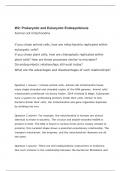
BIOL202 Week 2 Discussion; Prokaryotic and Eukaryotic Endosymbiosis
Week 2: Prokaryotic and Eukaryotic Endosymbiosis Animal cell mitochondria • If you chose animal cells, how are mitochondria replicated within eukaryotic cells? • If you chose plant cells, how are chloroplasts replicated within plant cells? How are these processes similar to microbes? • Do endosymbotic relationships still exist today? • What are the advantages and disadvantages of such relationships?
- Other
- • 2 pages •
Week 2: Prokaryotic and Eukaryotic Endosymbiosis Animal cell mitochondria • If you chose animal cells, how are mitochondria replicated within eukaryotic cells? • If you chose plant cells, how are chloroplasts replicated within plant cells? How are these processes similar to microbes? • Do endosymbotic relationships still exist today? • What are the advantages and disadvantages of such relationships?
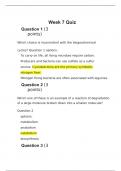
BIOL202 Week 7 Quiz
1. Question: Which choice is inconsistent with the biogeochemical cycles? 2. Question: Which one of these is an example of a reaction of degradation of a large molecule broken down into a smaller molecule? 3. Question: Which primary producer can be found in oceans? 4. Question: What are the wolves in Yellowstone National Park an example of? 5. Question: What statement is excluded in the relationship between Rhizobium and the roots of clover? 6. Question: What is excluded from the process of...
- Exam (elaborations)
- • 7 pages •
1. Question: Which choice is inconsistent with the biogeochemical cycles? 2. Question: Which one of these is an example of a reaction of degradation of a large molecule broken down into a smaller molecule? 3. Question: Which primary producer can be found in oceans? 4. Question: What are the wolves in Yellowstone National Park an example of? 5. Question: What statement is excluded in the relationship between Rhizobium and the roots of clover? 6. Question: What is excluded from the process of...
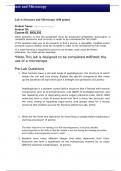
BIOL202 Week 4 Lab 4; Structure and Microscopy
Lab 4: Structure and Microscopy (100 points) ▪ Each question on the lab worksheet must be answered completely, thoroughly, in complete sentences and correctly in order to be considered for full credit ▪ If the question asks you to do research or find a source, a reputable, credible and/or scholarly source citation must be included in order to be considered for full credit ▪ If a math formula is required to arrive to an answer, work must be shown otherwise, no credit will be awarded ...
- Package deal
- Exam (elaborations)
- • 9 pages •
Lab 4: Structure and Microscopy (100 points) ▪ Each question on the lab worksheet must be answered completely, thoroughly, in complete sentences and correctly in order to be considered for full credit ▪ If the question asks you to do research or find a source, a reputable, credible and/or scholarly source citation must be included in order to be considered for full credit ▪ If a math formula is required to arrive to an answer, work must be shown otherwise, no credit will be awarded ...
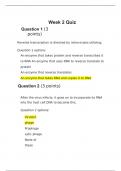
BIOL202 Week 2 Quiz
1. Question: Reverse transcription is directed by retroviruses utilizing; 2. Question: After the virus infects, it goes on to incorporate its RNA into the host cell DNA to become this. 3. Question: In this type of bacterial shape, it has the appearance of a comma. 4. Question: What are plasmids capable of? 5. Question: When is a genetic mutation suspected? 6. Question: The cell wall of a Gram positive bacteria was removed to result in the formation of a; 7. Question: What happens when a ba...
- Exam (elaborations)
- • 7 pages •
1. Question: Reverse transcription is directed by retroviruses utilizing; 2. Question: After the virus infects, it goes on to incorporate its RNA into the host cell DNA to become this. 3. Question: In this type of bacterial shape, it has the appearance of a comma. 4. Question: What are plasmids capable of? 5. Question: When is a genetic mutation suspected? 6. Question: The cell wall of a Gram positive bacteria was removed to result in the formation of a; 7. Question: What happens when a ba...

BIOL250 Week 15 Unit Exam 5
1. Question: Which nucleus in the medulla is connected to the inferior colliculus? 2. Question: The comparison of cerebral motor commands and proprioceptive feedback occurs where? 3. Question: The thalamus is the transfer point for most sensory tracts to reach the cerebral cortex. An exception would be which of these? 4. Question: Which region of gray matter in the spinal cord contains motor neurons that innervate skeletal muscles? 5. Question: Axons in which tract are considered to be both ...
- Exam (elaborations)
- • 20 pages •
1. Question: Which nucleus in the medulla is connected to the inferior colliculus? 2. Question: The comparison of cerebral motor commands and proprioceptive feedback occurs where? 3. Question: The thalamus is the transfer point for most sensory tracts to reach the cerebral cortex. An exception would be which of these? 4. Question: Which region of gray matter in the spinal cord contains motor neurons that innervate skeletal muscles? 5. Question: Axons in which tract are considered to be both ...
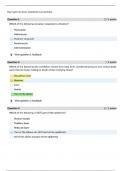
BIOL250 Week 9 Unit Exam 3
1. Question: Which of the following receptors responds to vibration? 2. Question: Which of the following skin conditions results from long-term, unrelieved pressure over certain body parts that are bony, leading to death of the overlying tissue? 3. Question: Which of the following is NOT part of the epidermis? 4. Question: The cuticle of the nail is also known as the ___________. 5. Question: Regarding the ABCDE mnemonic of a skin evaluation, "E" stands for ____________. 6. Question: Whic...
- Exam (elaborations)
- • 16 pages •
1. Question: Which of the following receptors responds to vibration? 2. Question: Which of the following skin conditions results from long-term, unrelieved pressure over certain body parts that are bony, leading to death of the overlying tissue? 3. Question: Which of the following is NOT part of the epidermis? 4. Question: The cuticle of the nail is also known as the ___________. 5. Question: Regarding the ABCDE mnemonic of a skin evaluation, "E" stands for ____________. 6. Question: Whic...
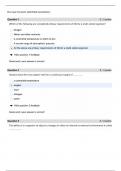
BIOL250 Week 3 Unit Exam 1
1. Question: Which of the following are considered primary requirements of life for a multi-celled organism? 2. Question: Humans have the most urgent need for a continuous supply of ________ 3. Question: The ability of an organism to adjust to changes in either its internal or external environments is called __________. 4. Question: Every cell in an animal is separated from other cells and from the extracellular environment by a cell (plasma) membrane. Which of the following are found inside ...
- Exam (elaborations)
- • 20 pages •
1. Question: Which of the following are considered primary requirements of life for a multi-celled organism? 2. Question: Humans have the most urgent need for a continuous supply of ________ 3. Question: The ability of an organism to adjust to changes in either its internal or external environments is called __________. 4. Question: Every cell in an animal is separated from other cells and from the extracellular environment by a cell (plasma) membrane. Which of the following are found inside ...

NURS 6051 Module 4 (Week 6) Discussion; Healthcare Information Technology Trends
NURS 6051 Module 2 (Week 3) Discussion; Interaction Between Nurse Informaticists and Other Specialists
O
NURS 6050 Module 5 (Week 9) Discussion; The Role of the RN-APRN in Policy Evaluation
NUR 590 Topic 2 Discussion 1 and Discussion 2 (+Responses)
NRNP 6552 Module 4 Week 10 Knowledge Check (Full 20/20 points Taken Spring 2022)